Alpha Beta … (2010)

Helen Hiebert
Lantern-structure book in open-sided box. Closed, H158.75 x W114.3 mm; opens out to 2971.8 mm. Box size: H171.45 x W114.3 x D133.35 mm.Edition of 25, of which this is #22. Acquired from the artist, 17 February 2021.
Each panel displays an alphabet letter cutout casting a shadow against a second layer of handmade paper. Appropriately, the letters follow in the Arts and Crafts style font designed by Dard Hunter, “the father of hand papermaking in 20th century America”, renowned scholar and author of Papermaking: The History and Technique of an Ancient Craft.




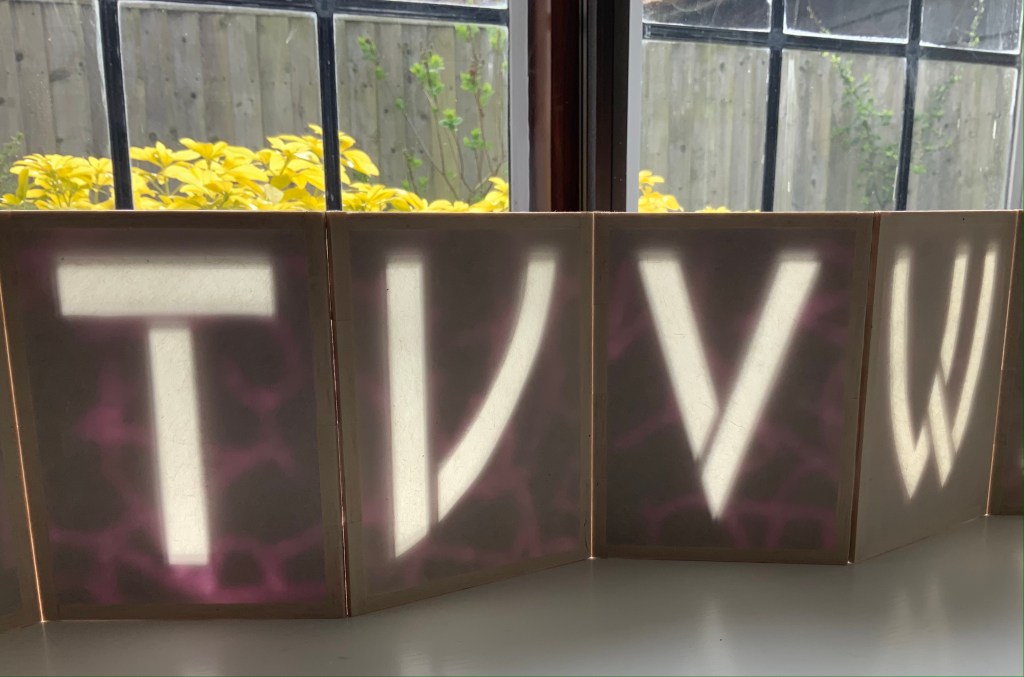
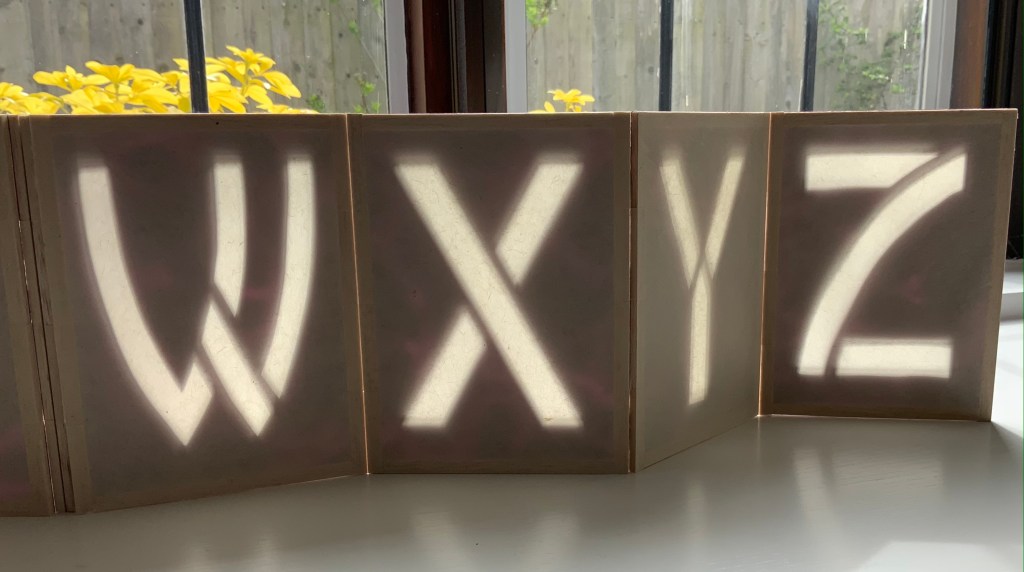
The book’s flexible hinges between the panels allow it to be set up in a variety of ways. As can be seen above and below, the right-reading alphabet appears on the less colorful side of the structure. When viewed from the more colorful side, the letters show in reverse, which is, of course, more evident with C-B-A than Y-X-W. The swirling strokes that shadow the right-reading letters reveal themselves on the more colorful side as asemic characters watermarked into the handmade paper. A fusion of paper, letters, form and meaning.


On the reverse side: C-B-A and Y-X-W.
The Secret Life of Paper: 25 Years of Works in Paper (2016)

The Secret Life of Paper: 25 Years of Works in Paper (2016)
Helen Hiebert
Artist-made paper covers sewn over two signatures with an original string drawing in the center. H282 x W218 mm, 22 pages. Acquired from the artist, 4 April 2016.
Photos: Books On Books Collection.
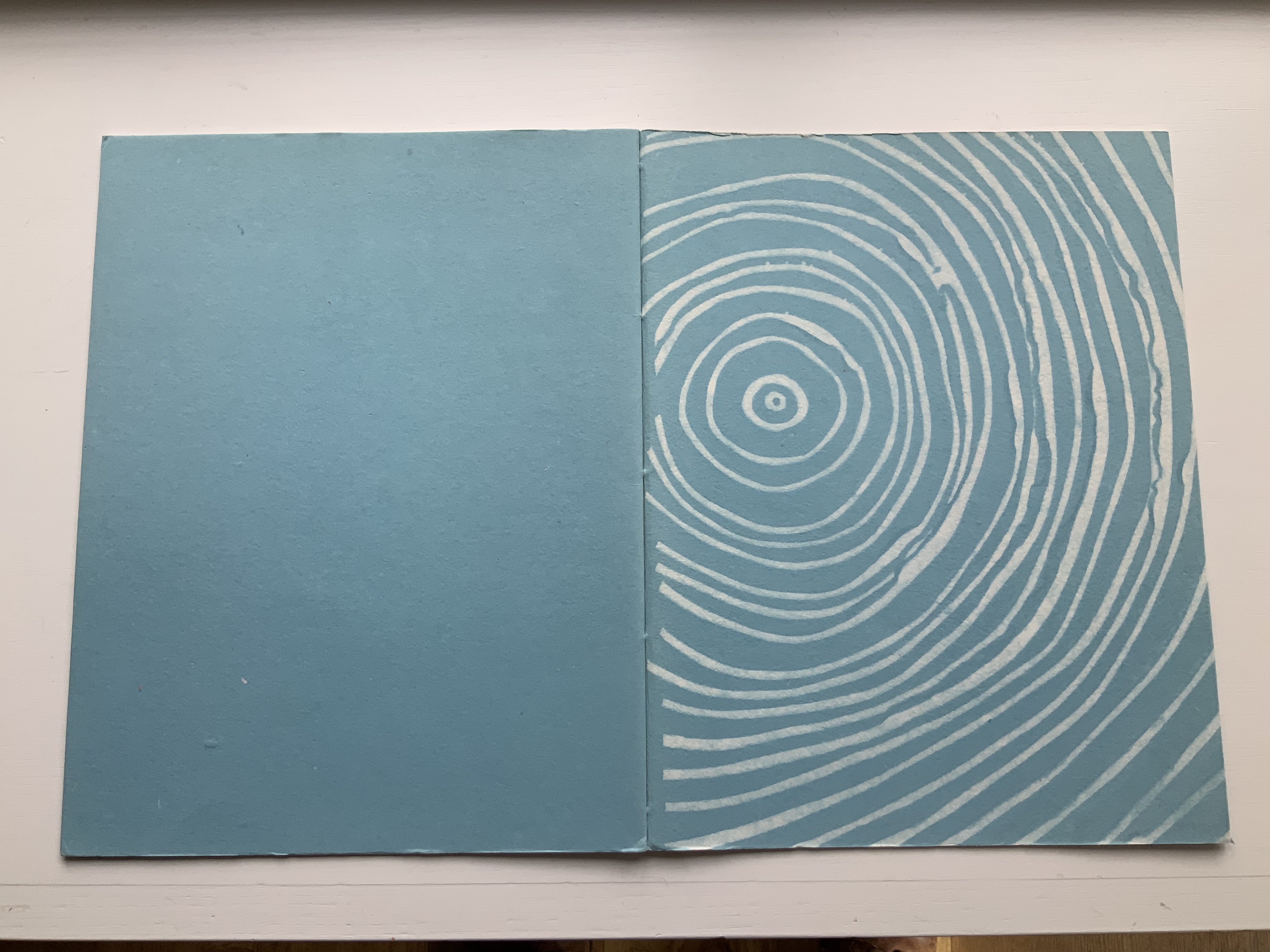




Catalogues like this are works of art about works of art. It came about as a result of an exhibition held at the Kalamazoo Book Arts Center and the Waldo Emerson Library at Western Michigan University. The catalogue contains an illustrated chronology of the artist’s art and career up to 2015-16. Not only does it contain that work of string art in its center, its cover is hand bound and features a pulp stenciled handmade paper.
Curated Paper Collection #1 (2021)
Hiebert has begun a series of curated collection of papers from around the world. The first collection contains eleven papers. The largest sheet comes from Laureli Spokes: a handmade recycled rag paper from India (100 gsm), 357 x 502 mm. It features an exclusive retro two color silkscreened design that features a retro two-color silkscreened design. The smallest sheets are ten 200 x 200 mm squares of Kite Paper at 42 gsm in brilliant colors. Similar to waxed paper, it is translucent and folds well.


In material and process, the two most interesting papers are Tangram Watermark (100 gsm with thinner watermarked areas, 310 x 460 mm) and Portugese Cork Paper (140 gsm, 255 x 255 mm). Handmade with 100% bleached flax fiber and deckle-edged on all four sides, the Tangram Watermark comes from the Helen Hiebert Studio. The first image below shows the deep impression left by the watermark design cut out of a thin vinyl material and adhered to the papermaking mould. The second image, created with the sheet held up to the light, shows more clearly the tangram design left as a sheet is pulled. The cork tree sourced is highly renewable and organically grown. Handmade in Portugal from the tree’s outer bark, the naturally water-resistant sheet consists of thin layers of cork laminated to a coated base paper. The cork is acid free, but the backing paper, shown in the last image, is not.
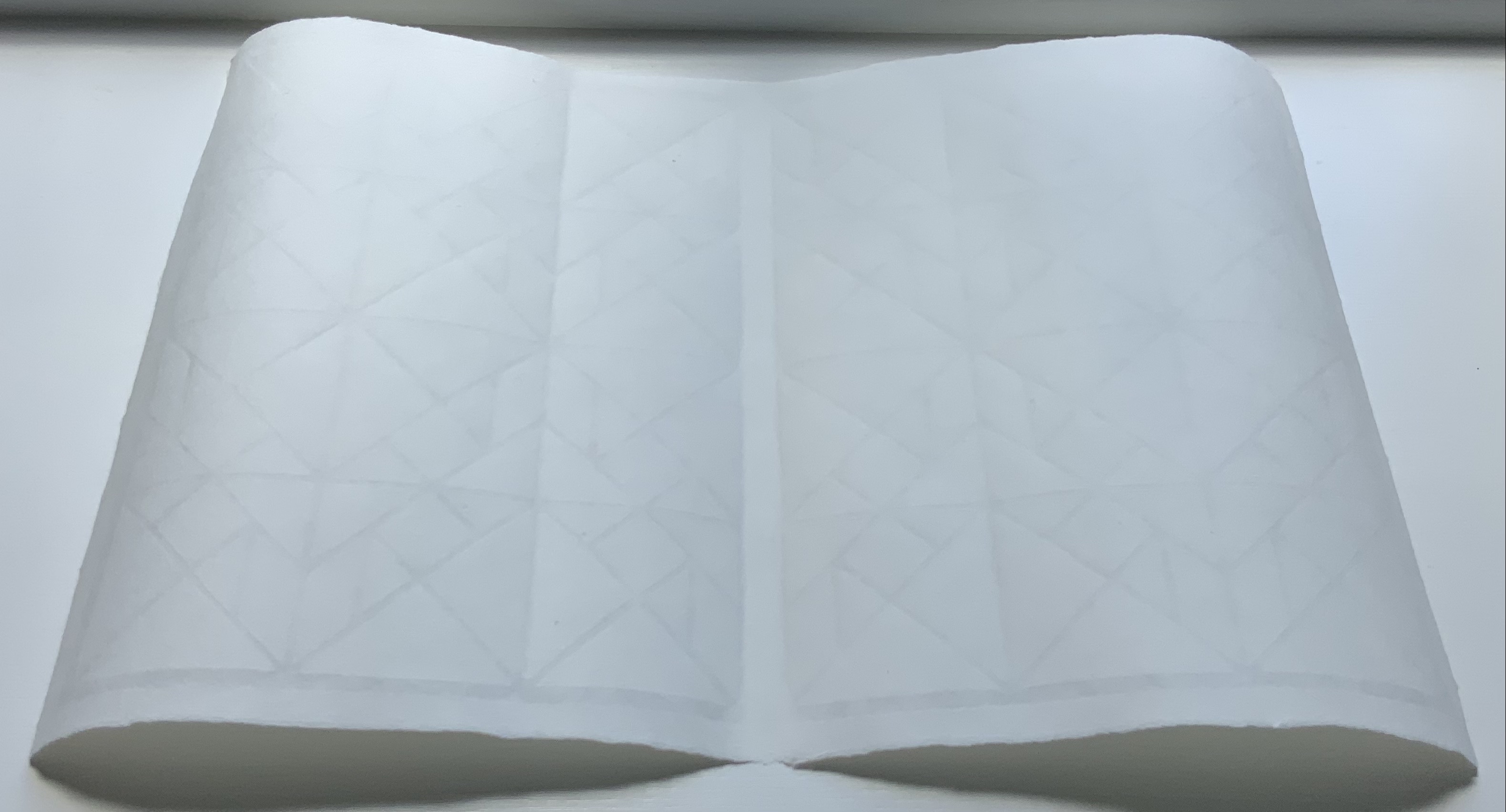

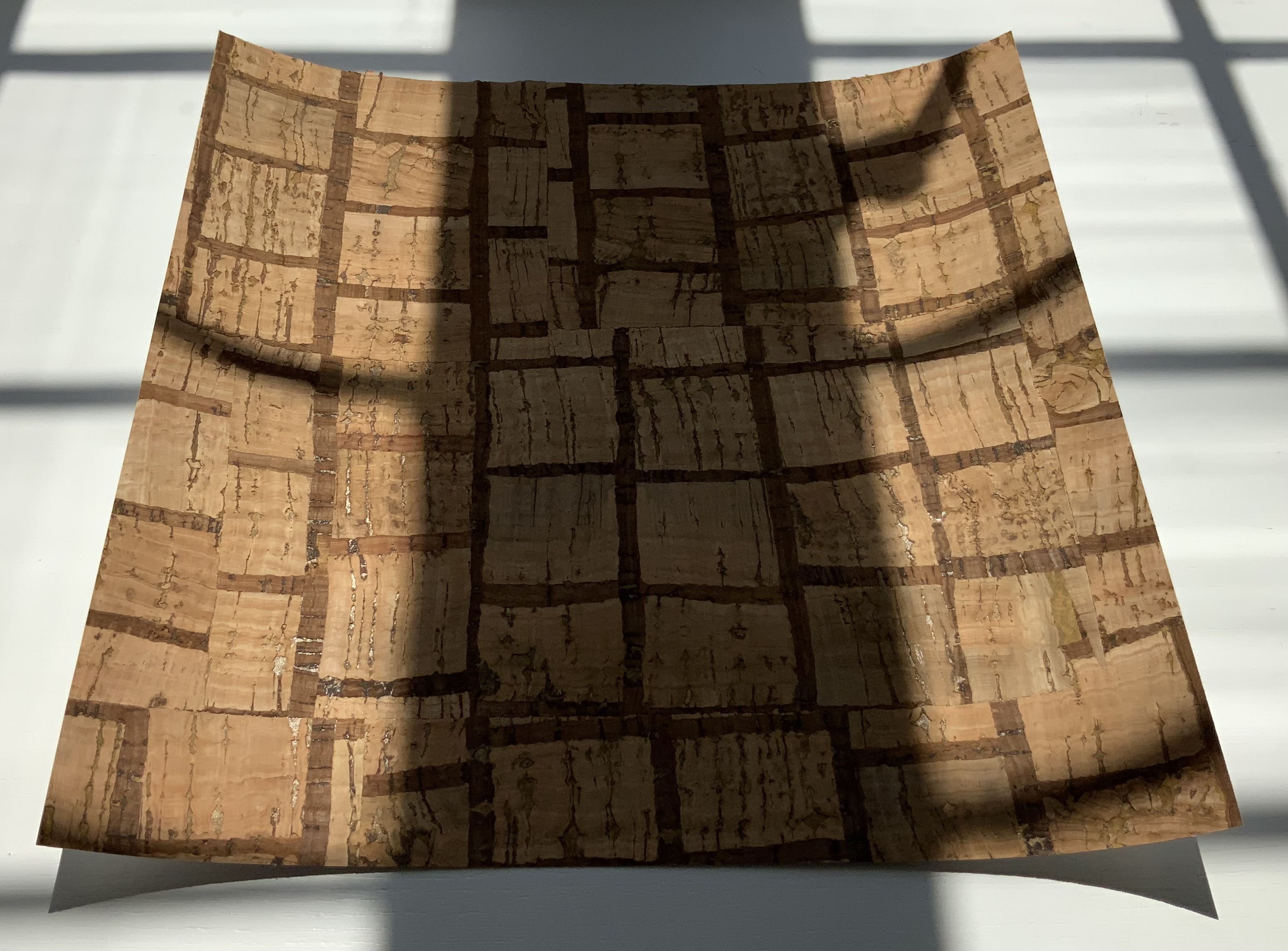

The next two curated papers show similarities and differences arising in the Japanese and Korean traditions. The Nanohana Washi (48 gsm, 315 x 470 mm) is a “nature paper” from Awagami Factory in Tokushima, Japan. The images show the changes under different light and from views of different sides. Traditionally, Japanese washi (like Korean hanji) is made from mulberry plant fibers. Here, Awagami has used the nanohana plant (related to broccoli). It grows along the local Yoshino river, and Awagami collects the florets each Spring to mix into these sheets of washi, resulting in the green and yellow flecks. The lightweight hanji (15-19 gsm, 325 x 490 mm) is made from 100% dak (mulberry) fiber, grown and harvested in Korea by Seongwoo Jang, a fourth generation papermaker at Jangjibang, a hanji mill in Gapyeong, Korea. Hiebert notes, “The sheet was formed using the traditional Korean technique called webal or heulim ddeugi, where the slurry flows onto and off the frame in multiple directions, resulting in a strong sheet without a prominent grain direction”. The images in the middle row aim to show this with the sheet laid atop dark art paper in full sunlight and draped over the hand. The detail of the corner in the last row shows the two-ply of the sheet, where — in another interesting difference between the washi and hanji –two thin layers were couched together to form a single strong hanji sheet.



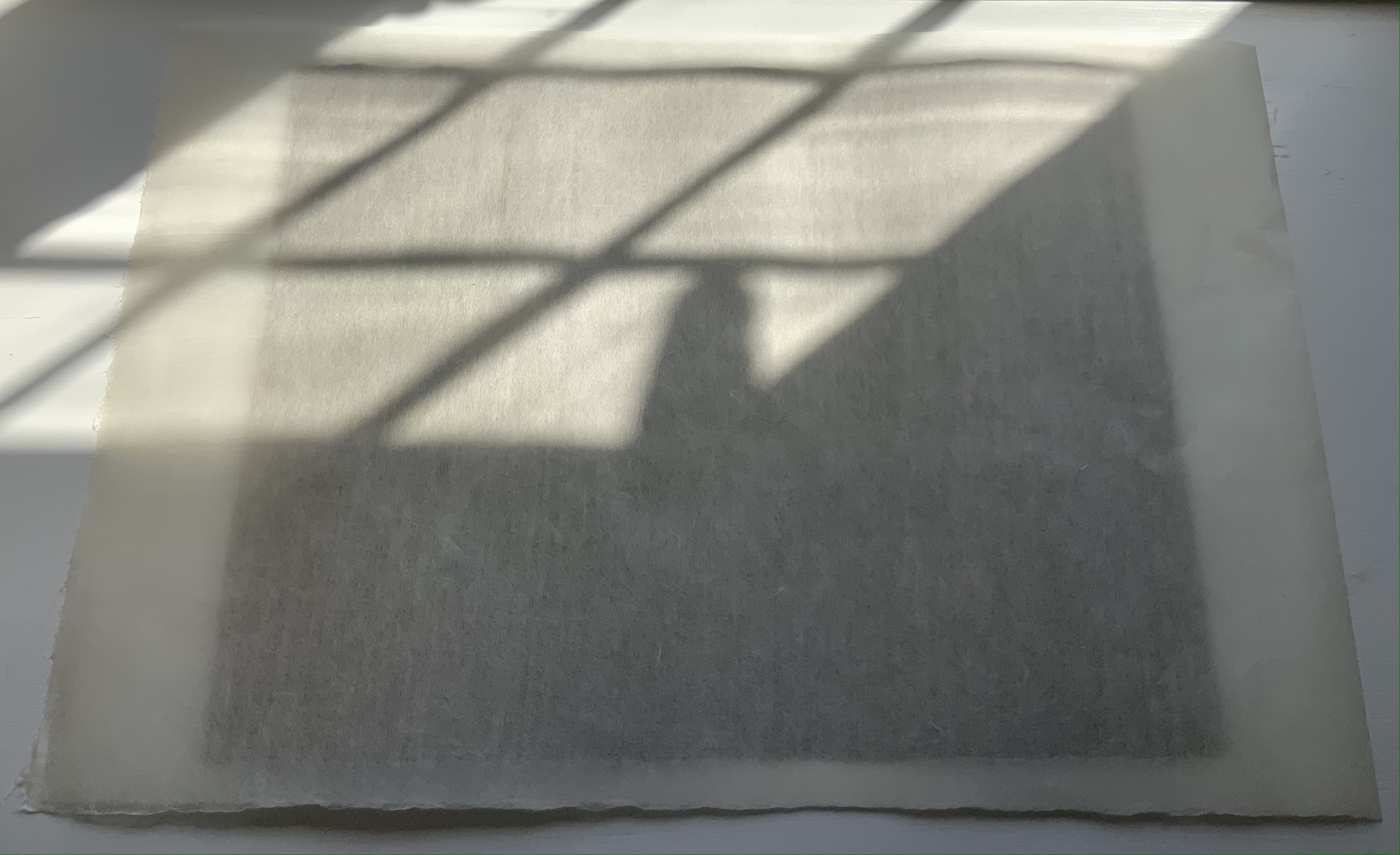


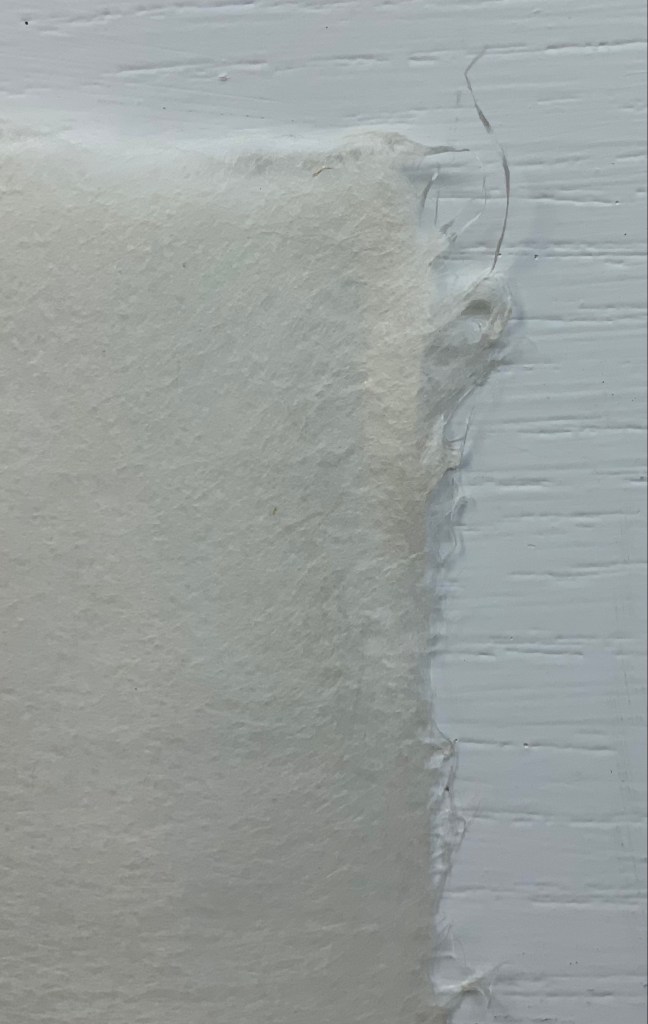
The next two papers are paired for uses and decorativeness. The silk-screened, matte-finish Italian Carta Varese Origami Paper (100 gsm, 350 x 500 mm) is heavier than traditional origami paper, it has a smooth surface and creases well with crisp folds. Smooth-surfaced and creasing well for turned in corners, this sheet with its red scroll pattern would serve well for endpapers. Debra Glanz designed the next set of papers — Paper Assembly (28#-32# text weight, 305 x 305 mm) — with that use, among others, in mind for book and paper artists.


The next two papers demonstrate the curator’s attraction to painterly surfaces. Silkscreen printed by hand with a lacquer-like ink, the Red and Blue Dragonfly Pattern Japanese Lacquered Yuzen Paper (140 gsm, 330 x 485 m) has the depth, texture and glow Japanese lacquer ware, which the first three images attempt to convey. The painting base consists of kozo and wood sulfite. The sheet of paste paper (230 x 305 mm) in the last image comes from the late Louise Lawrence (Larry Lou) Foster. It has an op-art feel to it. More of her unique papers painted with pigmented paste can be found in the limited-edition book The Paste Papers of Louise Lawrence Foster and in the Metropolitan Museum’s Thomas J. Watson Paper Legacy Project.

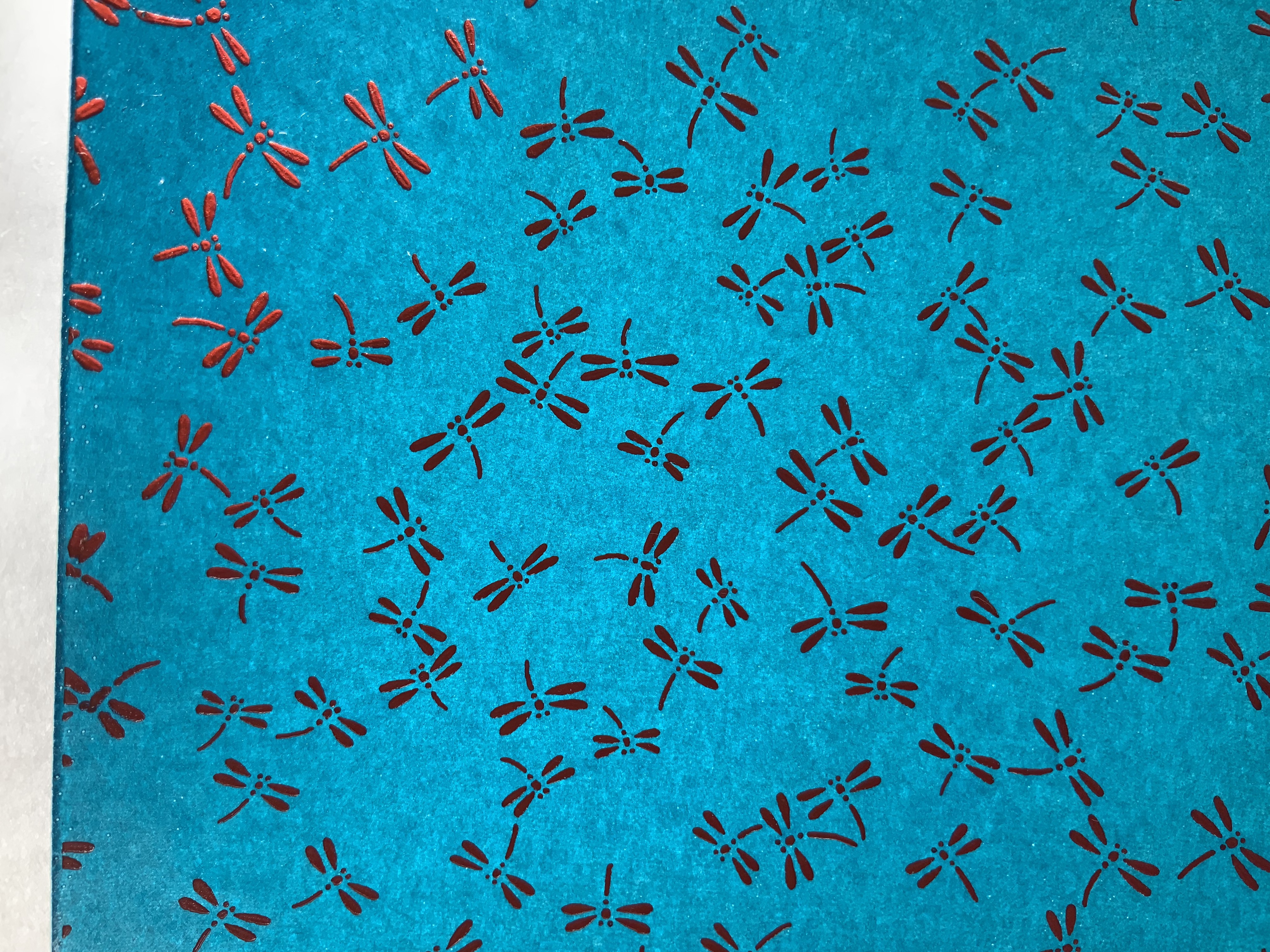


A blend of abaca fibers and cotton rag, Bistre Mixed Media (150 gsm, 280 x 360 mm) from Kelsey Pike’s Sustainable Papercraft in Kansas City, Kansas, is at once hard, resilient, durable, bulky, thick and soft. The images below attempt to show the sheet’s homogeneous surface and smooth, fine grain texture, intended as the name suggests for all fine art media – pencils, charcoal, conte, pastel, acrylic, watercolor, ink, gouache, etc.



For the Books On Books Collection, Curated Collection #1 presents a challenge for display and storage alongside Fred Siegenthaler’s Strange Papers and the Gentenaar-Torley’s first seven books of the Rijswijk Paper Biennial. Helen Hiebert’s contribution to book and paper art warrants that place.
Curated Paper Collection #2 (2021)
Hiebert’s second round of curation comes with a helpful printed cheat sheet (although it was challenging fun to identify the samples in #1 without the initial help). With inclusion of a video link for creating a “butterfly” book, the cheat sheet also recalls Hiebert’s bustling business in lectures and workshops as well as tempts a collector to raid the collection with a ham-handed attempt.
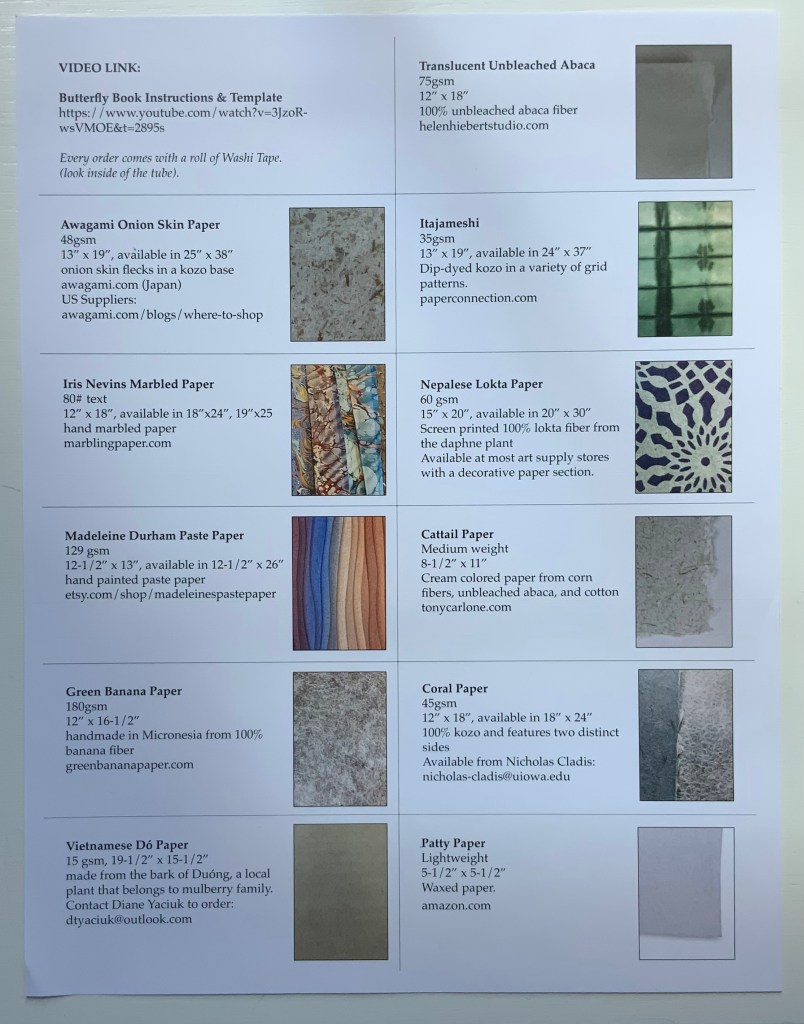
The first paper in the curation comes from the Fujimori family business. According to its website, 6th generation Minoru Fujimori took over in 1945. In 1970, he was designated an “Intangible Cultural Property of Tokushima” in recognition of his skills. In 1976, Awagami washi was designated as a “Traditional Craft Industry”. In 1986, Fujimori-san was further honored as Master Craftsman and awarded the “Sixth Class Order of Merit, Sacred Treasure” by the Emperor.
Naturally the flecks of onion skin show up differently on the two sides of the sample, and the density almost completely disguises the lines of the mesh. The way the color varies in the light at different angles accentuates the supple drape of the paper.
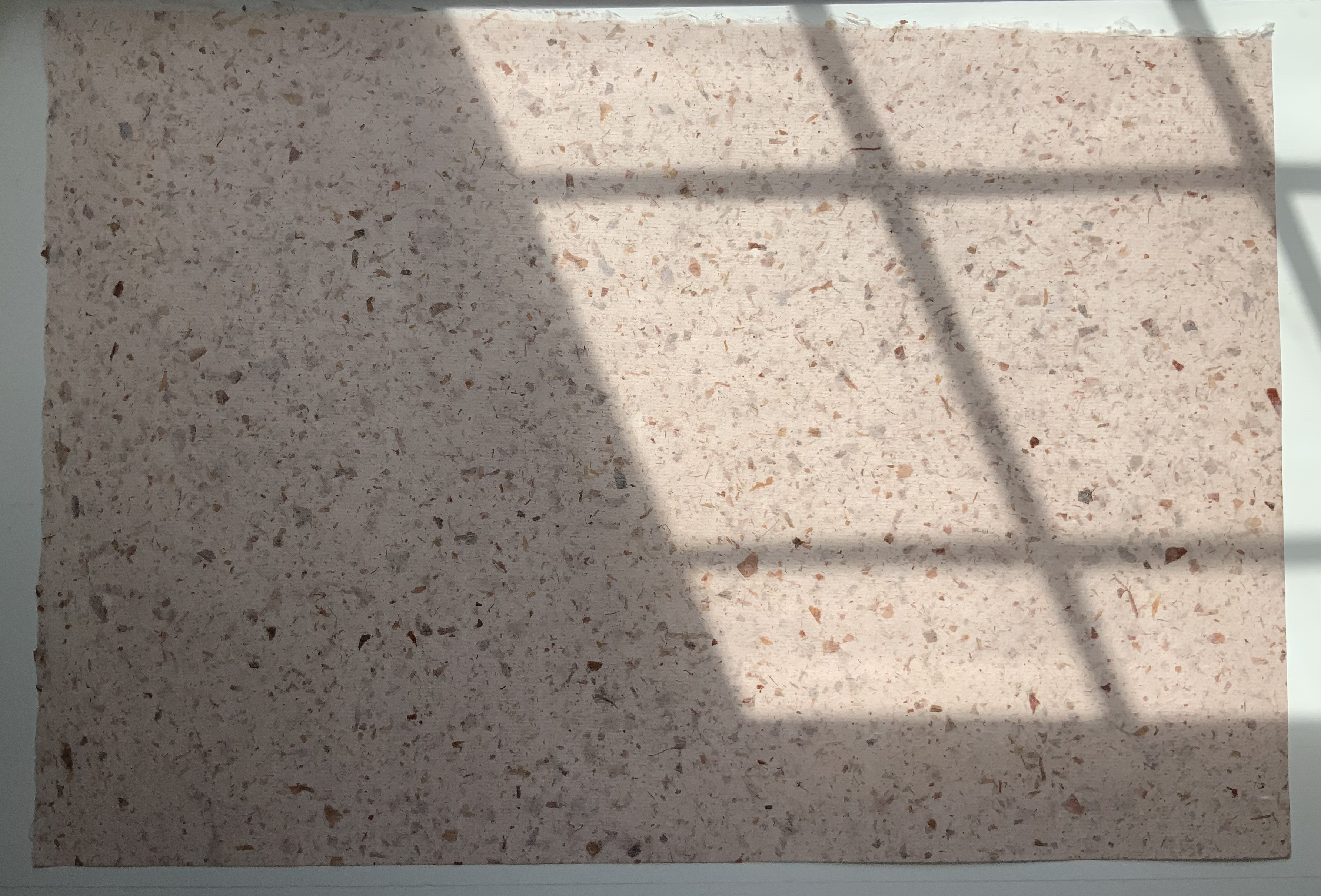
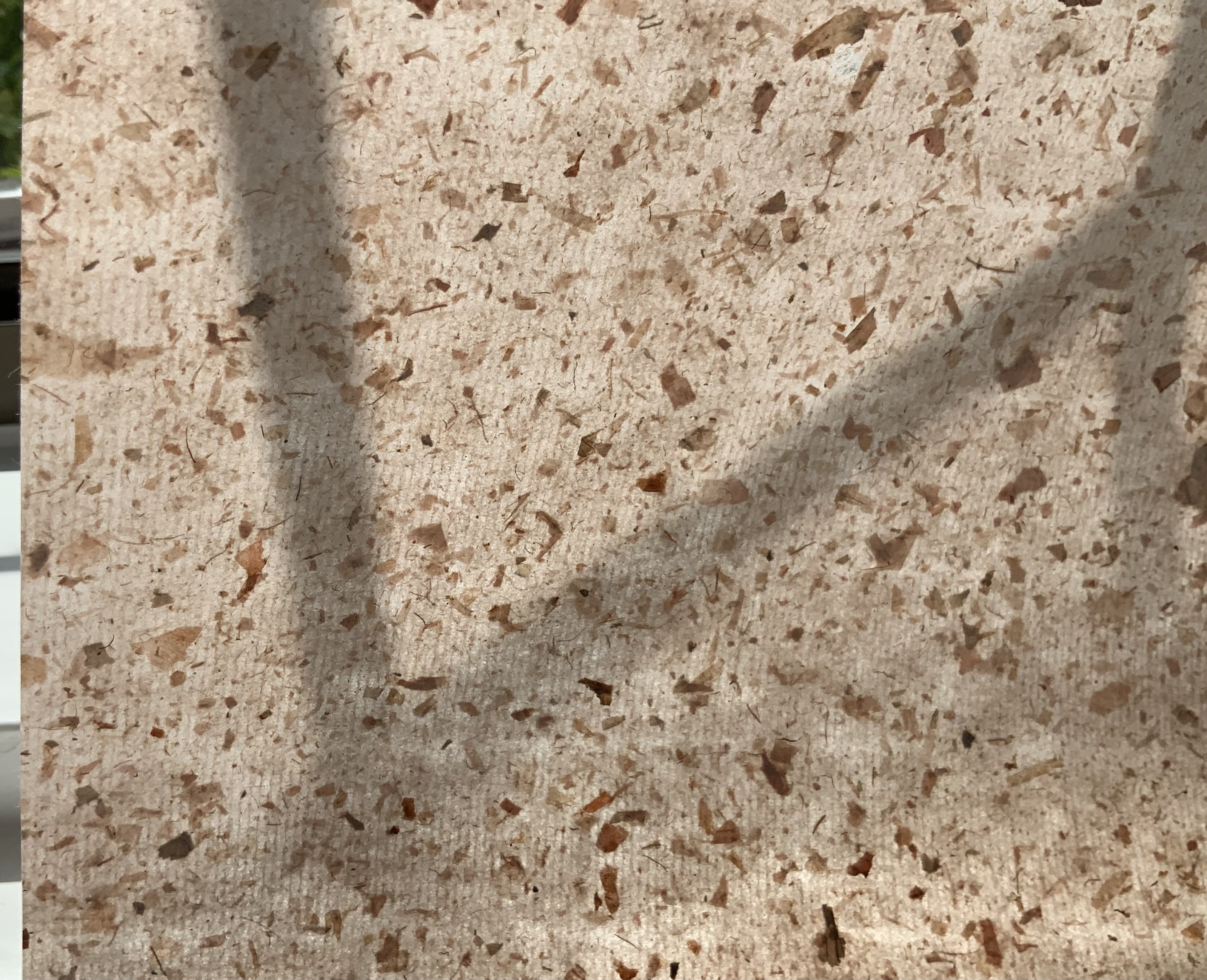

Awagami Onion Skin Paper, 48 gsm
Like Minoru Fujimori above, Iris Nevins is a cultural treasure. Specializing in the reproduction of early marbled papers, she has delved into its past prior to the advent of marbling machines during the Victorian era and creates her “own marbling colors using, where possible, the same pigments used during the period”. On what shelves and in what crusty containers do such pigments reside?
As of August 2021, her work is still being accessioned by the Paper Legacy Project, a permanent collection house in the Metropolitain Museum Of Art, in The Thomas J. Watson Library.
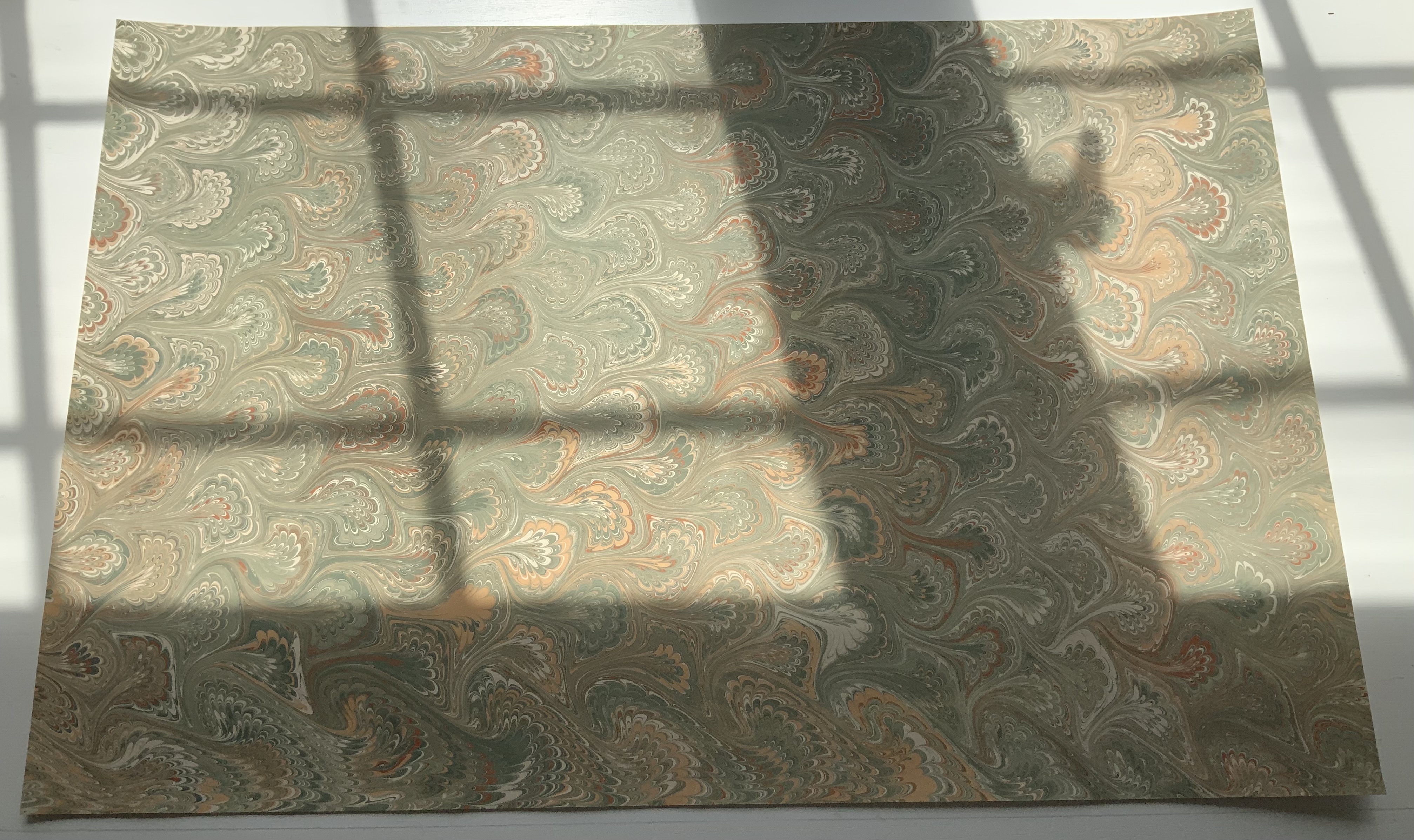
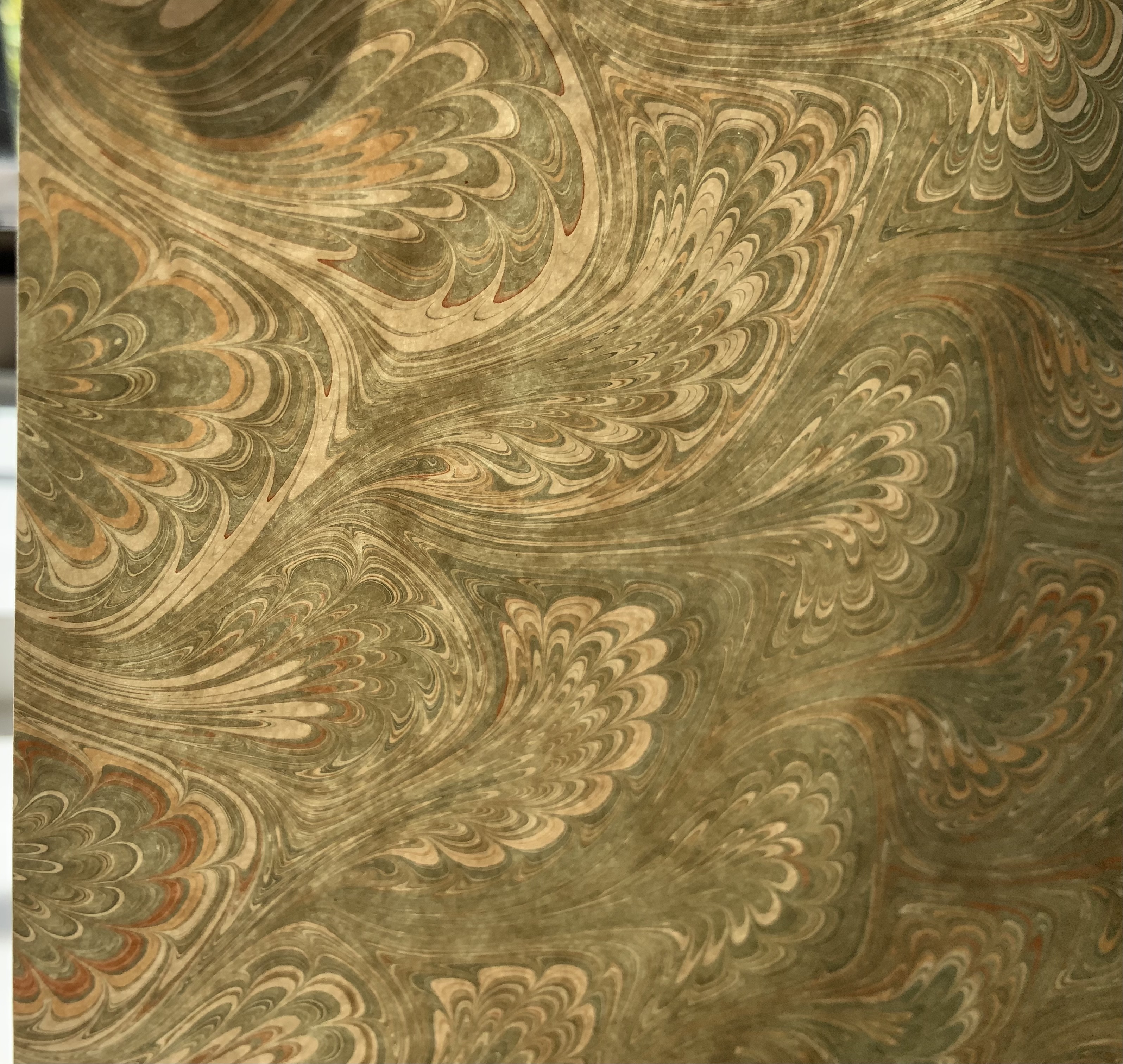
Iris Nevins Marbled Paper
Madeleine Durham’s paste paper is also part of the Watson Library Digital Collection. In her artist’s statement, she refers to samples “representative of my landscape artwork”. With the sample that follows, dunescapes and seascapes come to mind.
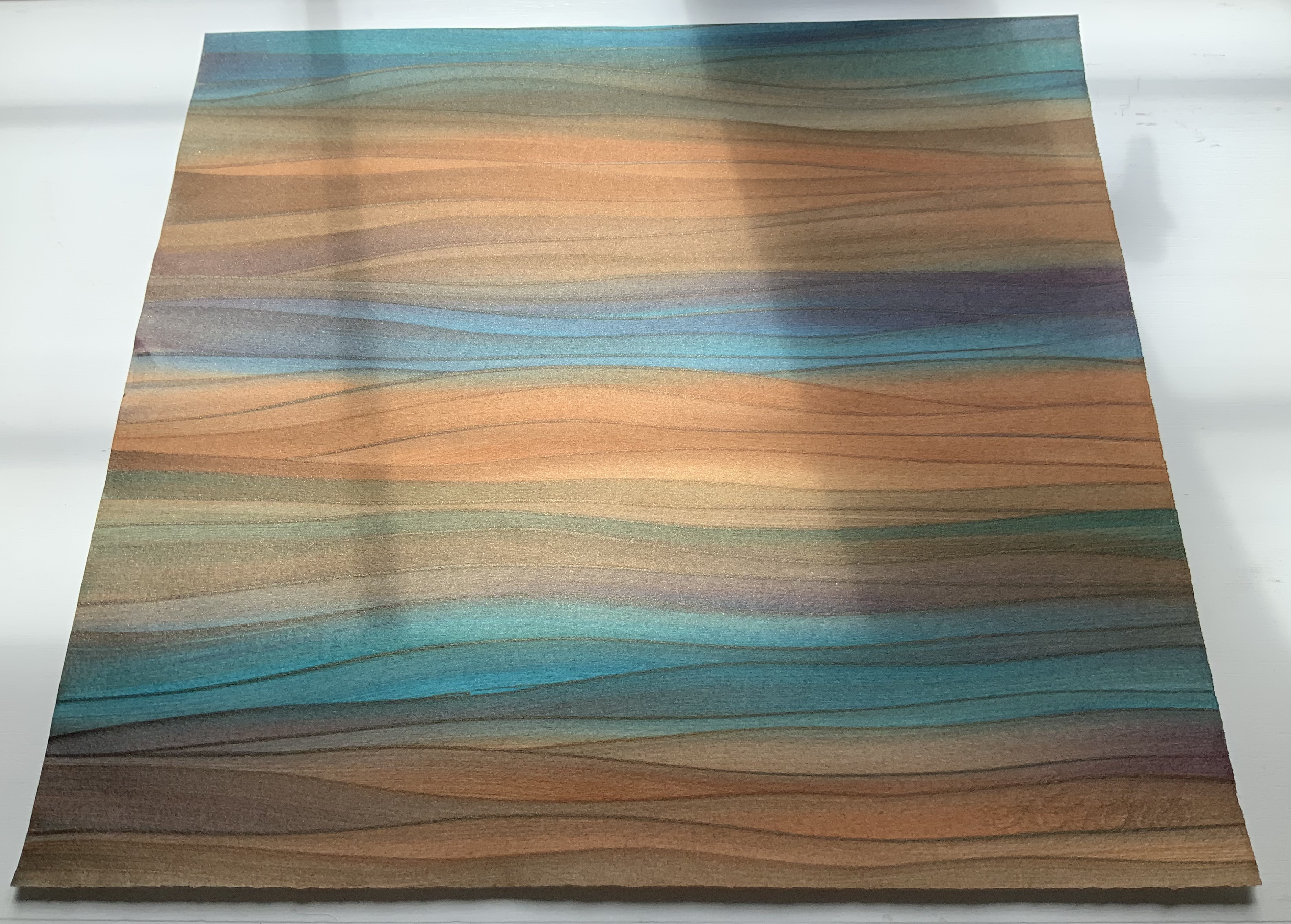

Madeleine Durham Paste Paper, 129 gsm
This green banana paper comes from a company of the same name based in Kosrae, Micronesia. Among its products is the Green Banana Paper Wallet. The pictures cannot do justice to the toughness and almost slick feel of this paper. A raincoat or wallet made from it would keep a person and valuables dry and safe.
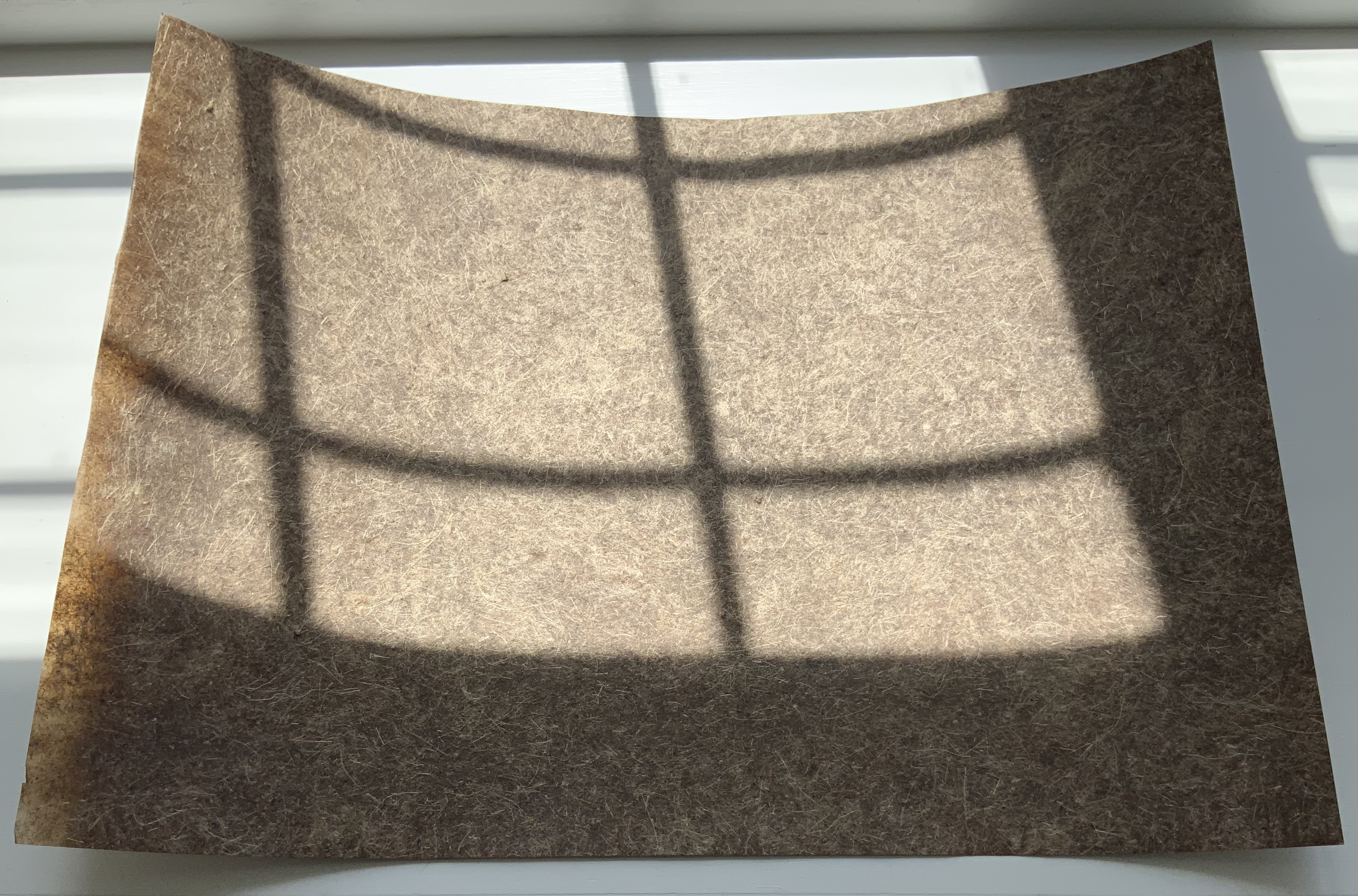
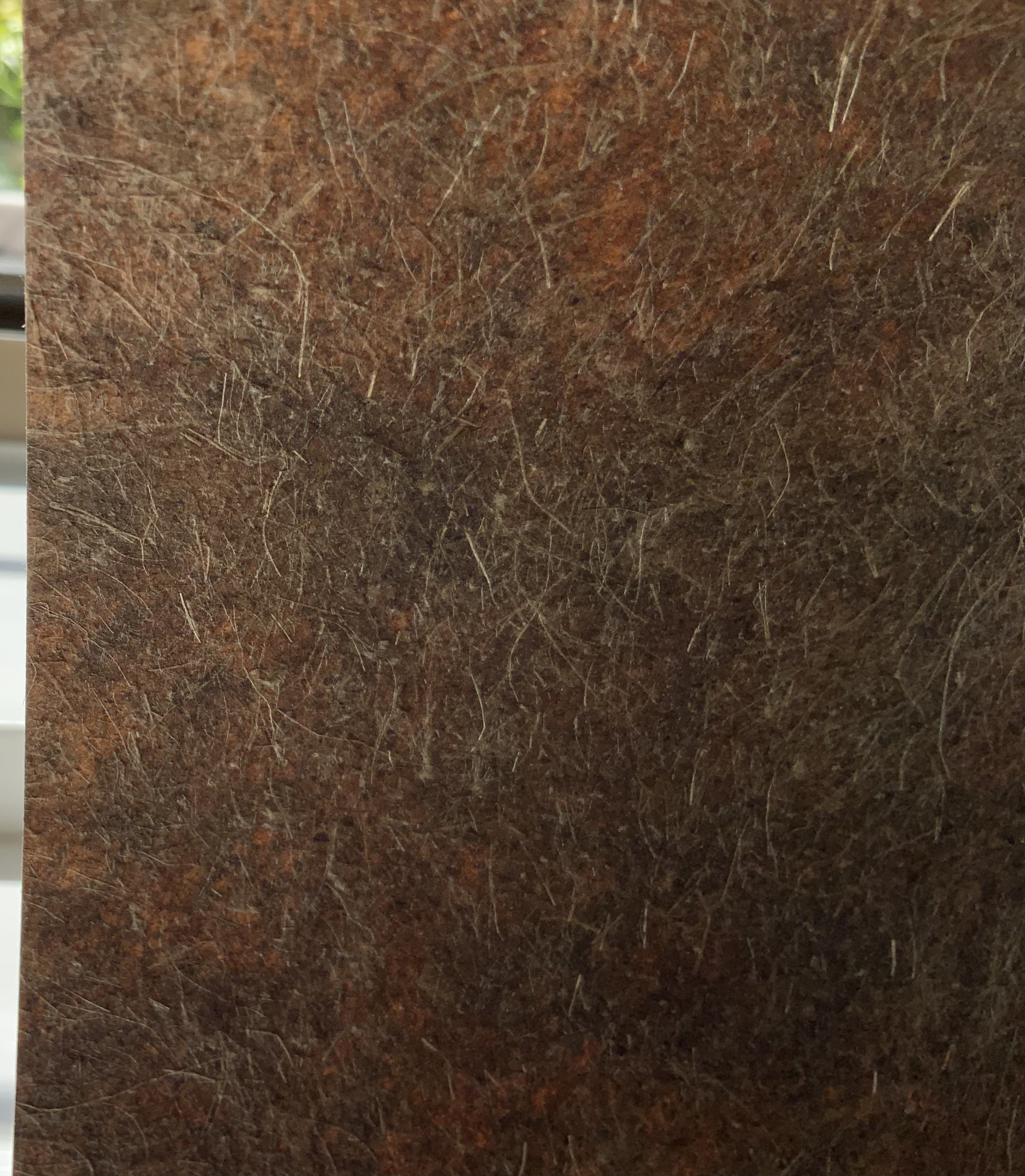
Green Banana Paper, 180 gsm
Dó paper is a traditional Vietnamese hand-made paper dating back to the 3rd century BC. Made from the self-stripping bark of the Rhamnoneuron balansae tree, Dó paper appears to be headed toward the state of papyrus. Urbanization leading to scarcity of the tree, the narrow seasonality of the bark’s availability (between August and October) and incursion of industrial paper production pose sharp challenges to its survival. The sample below may become a rarity.
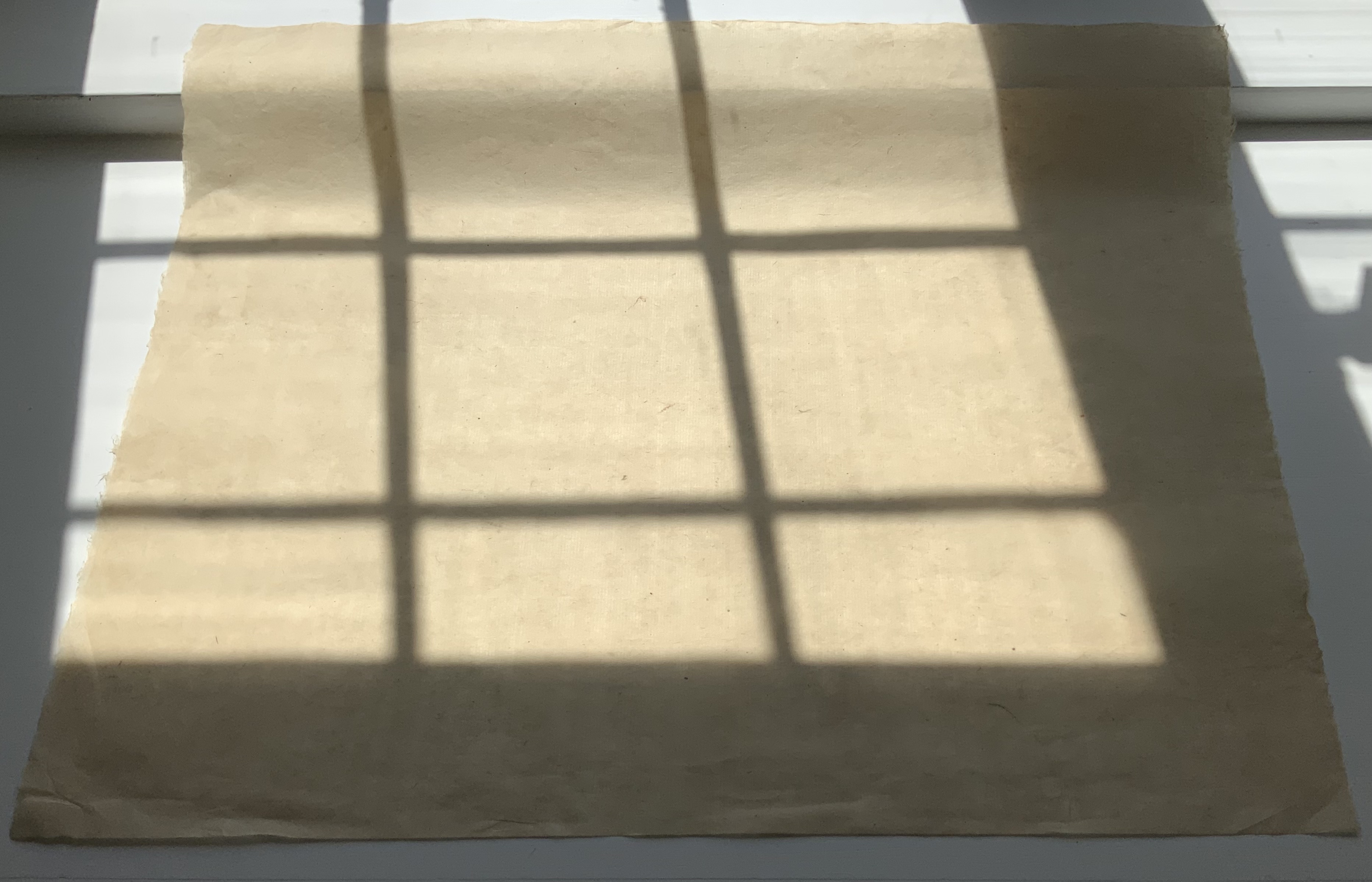

Vietnamese Dó Paper, 15 gsm
This piece of translucent unbleached abaca is best appreciated alongside Hiebert’s video “Making a sheet of abaca” (15 August 2020).


Translucent Unbleached Abaca, 75 gsm
Like Shibori, this paper below is thin or tissue washi that has been folded and dyed. The dark, irregular lines where the dye has accumulated in the folds create a sharp contrast with the translucence of the laid lines and chain lines imprinted by the mesh in the papermaking frame.

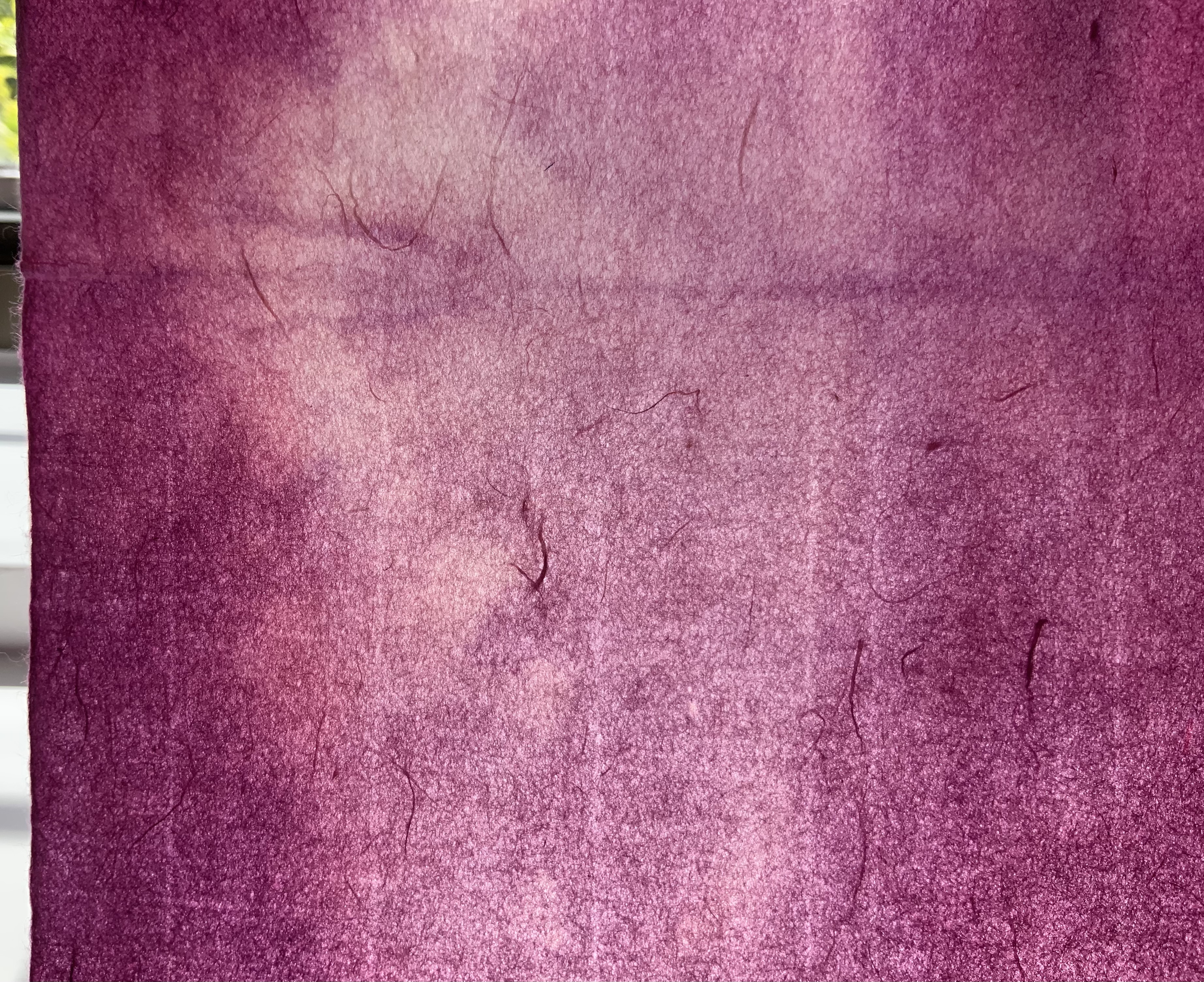
Itajameshi, 35 gsm
Manohir Upreti discusses lokta paper, “the King of Nepalese paper”, in the Geest van papier = Spirit of paper (2004), one of the Rijswijk Biennial volumes put together by Peter and Pat Gentenaar-Torley. Upreti’s sample and this one below from Hiebert’s curation demonstrate the dramatic patterns possible with this paper.
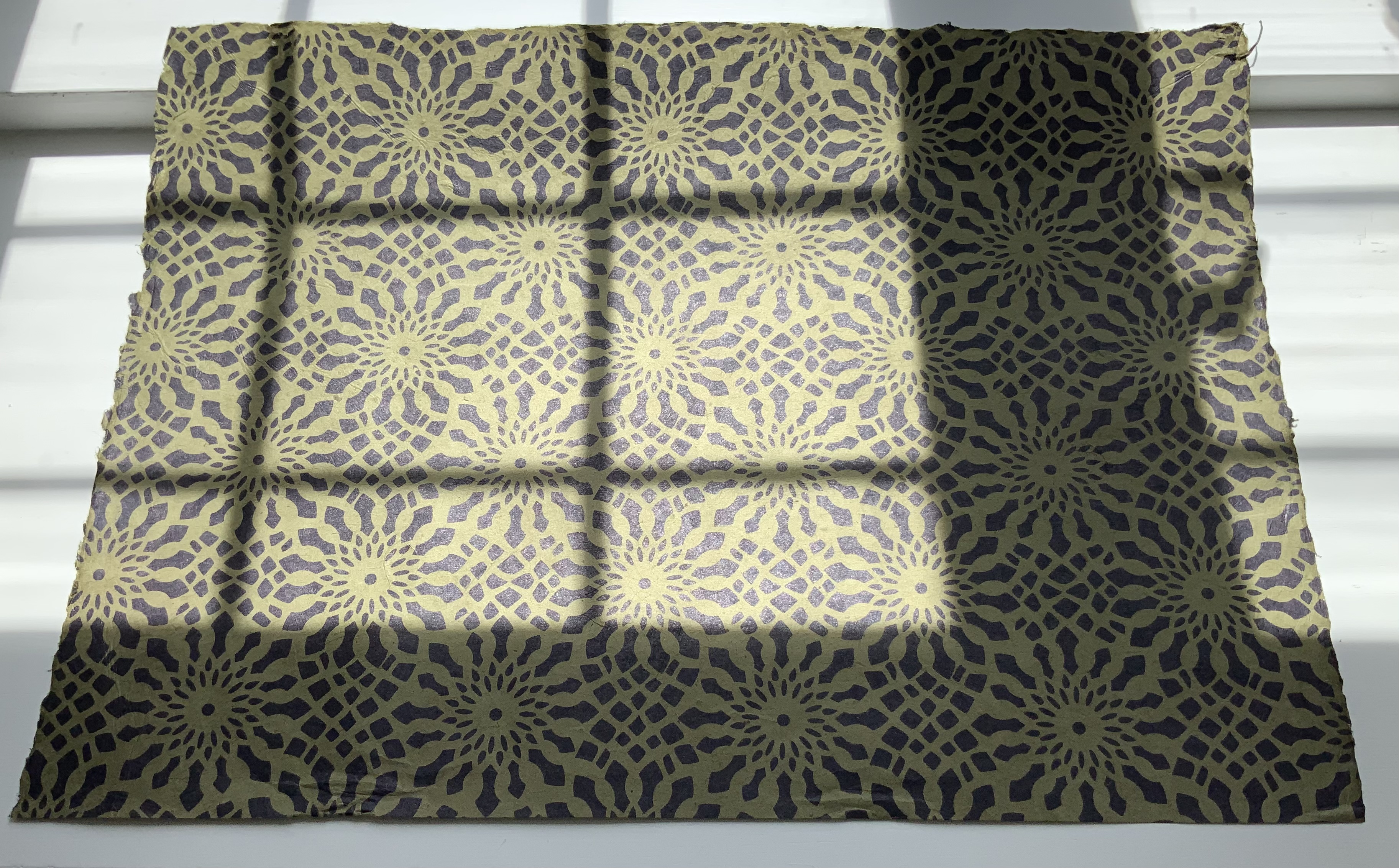

Nepalese Lokta Paper, 60 gsm
Tony Carlone‘s cattail paper reflects his artistic aim to source material “in a proper and sustainable manner”. His output includes sculptural pieces formed by spraying, pouring and casting processes, large-scale pulp paintings, and straightforward flat sheets for print processes. The cattail paper appears heavy but is actually light and supple.
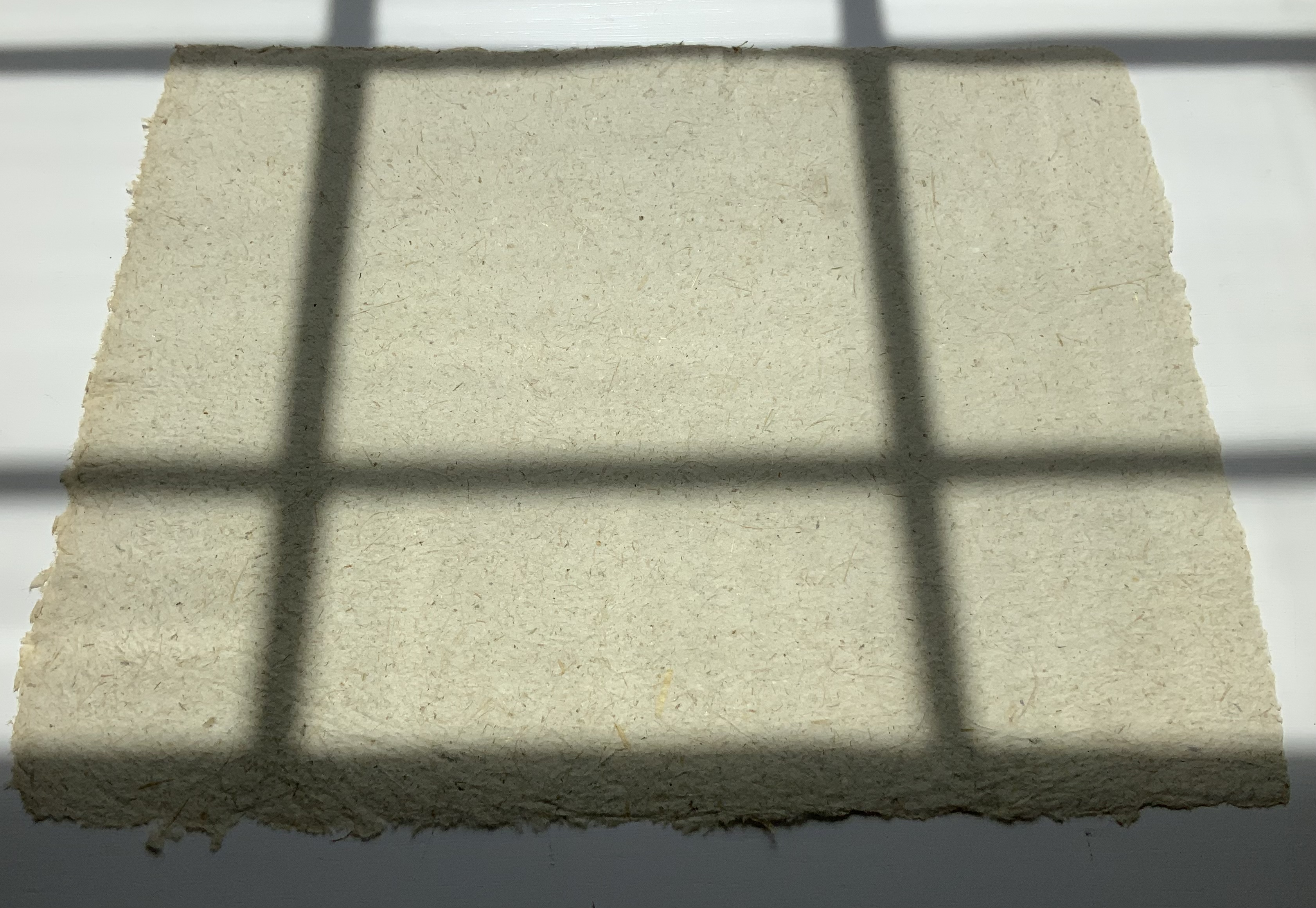


Cattail Paper, medium weight
Nicholas Cladis is an American-born interdisciplinary artist who lives and works in Fukui Prefecture, Japan. An active researcher and practitioner of traditional and non-traditional papermaking processes, he makes the paper elements of his work in Echizen—an area with over 1,500 years of papermaking history—and is also an international liaison for the papermaking community there. The contrast of the Coral paper’s two sides invites standing a window and turning the sheet over and over against the light.
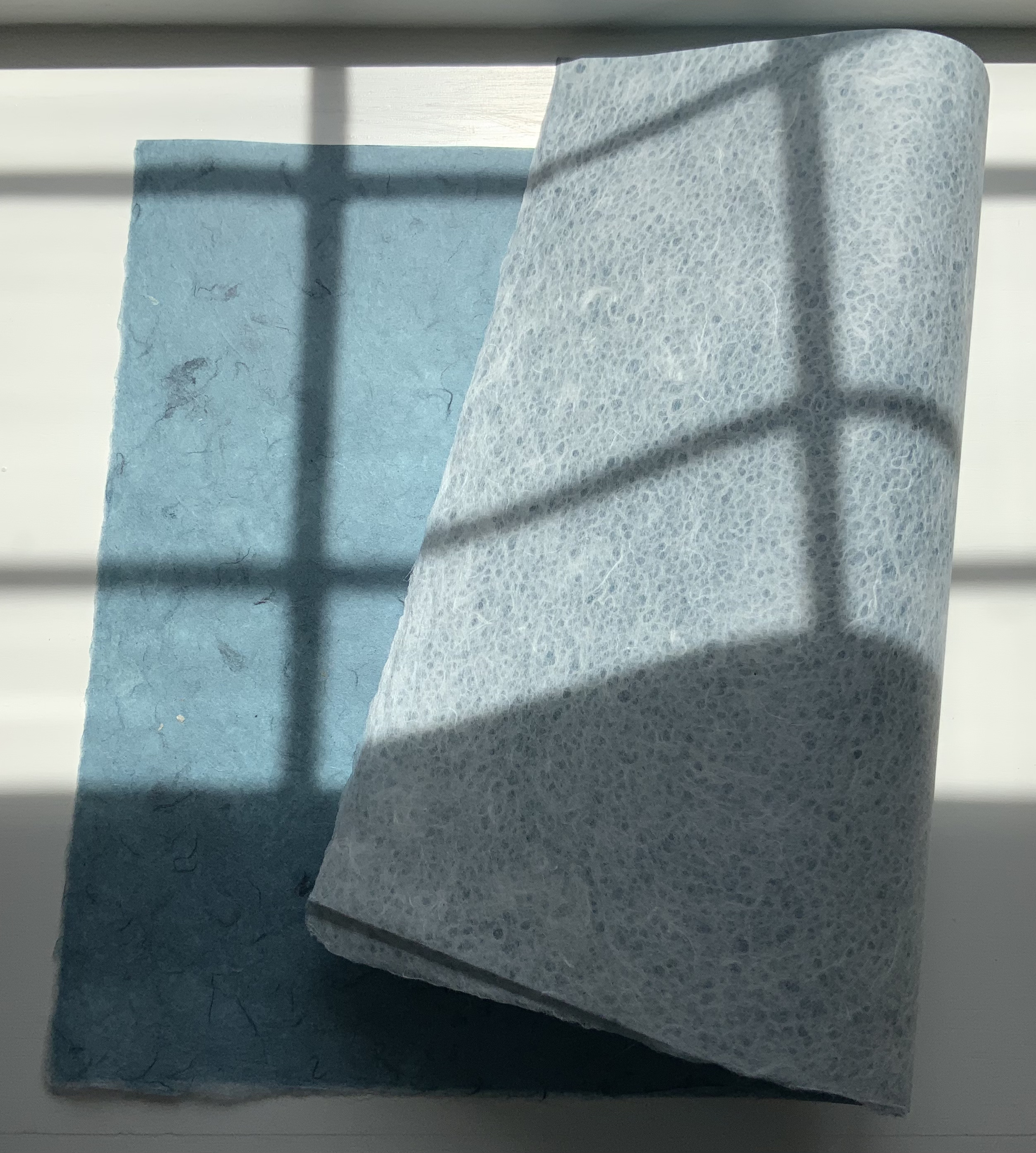

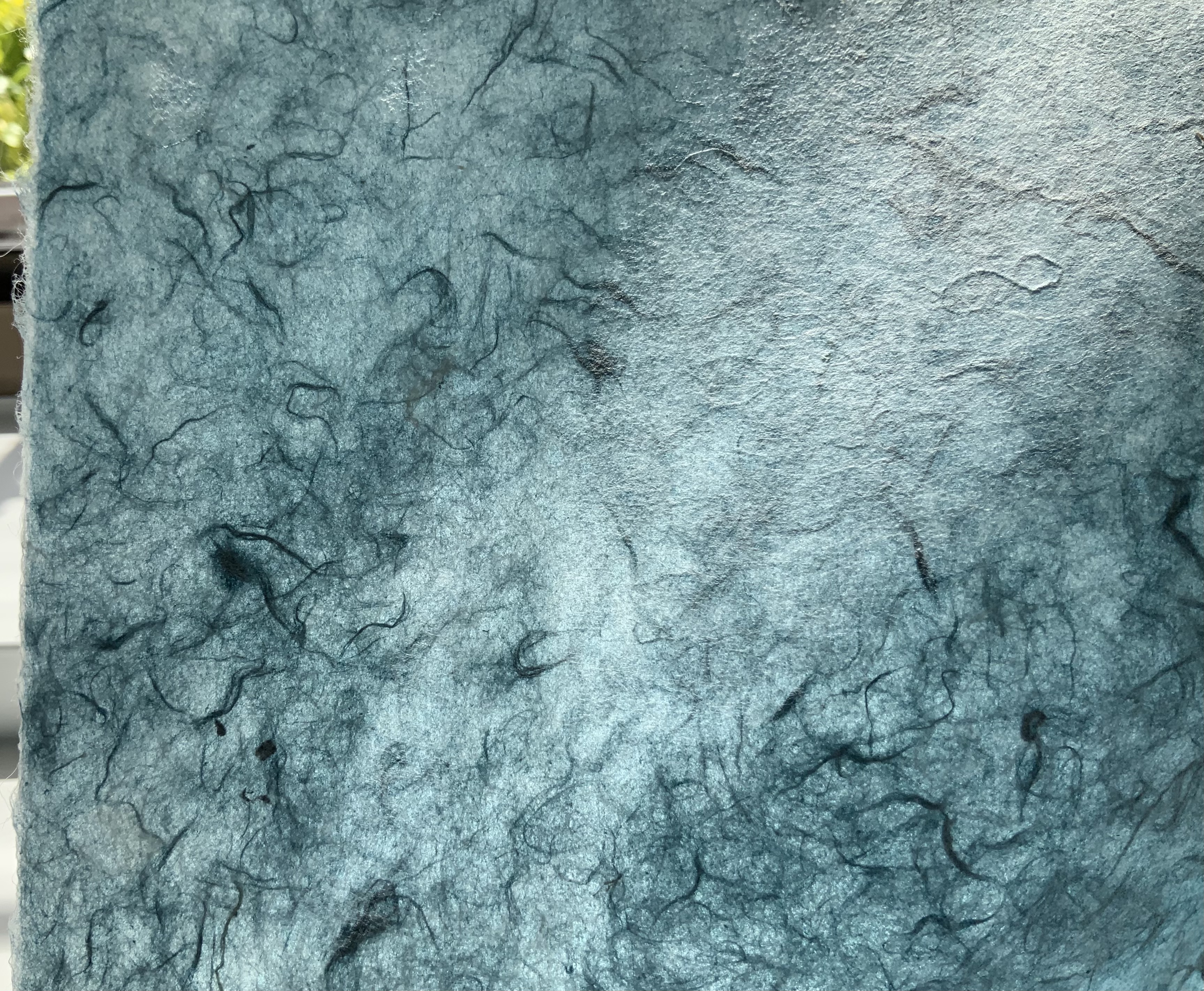
Coral Paper, 45 gsm
Patty paper, as in waxed paper for food patties, makes its way into Curated Paper Collection #2 for its properties of translucence, proportions suited to origami and challenge as a printing surface. While a butterfly book might make result in an interesting use of this paper, a White Ermine Moth book would respond to all three features.
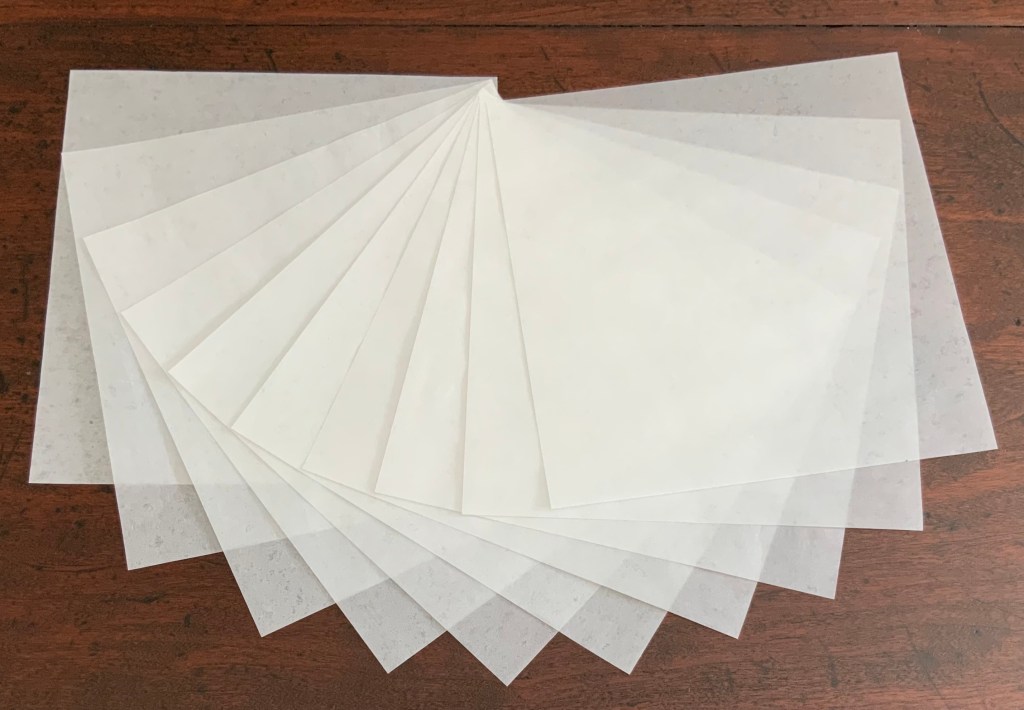
Patty Paper, lightweight
Further Reading
“Abecedaries I (in progress)“, Books On Books Collection, 31 March 2020.
“The First Seven Books of the Rijswijk Paper Biennial“, Books On Books Collection. 10 October 2019.
“Fred Siegenthaler“, Books On Books Collection. 10 January 2021.
Baker, Cathleen, and Frank Brannon. 2009. The Paste Papers of Louise Lawrence Foster. Whittier, North Carolina: SpeakEasy Press.
Hunter, Dard. 1978. Papermaking: The History and Technique of an Ancient Craft, 2nd ed. New York: Dover. Republication of the second, revised and enlarged 1947 edition.
Hiebert, Helen. 2012. The papermaker’s companion: the ultimate guide to making and using handmade paper. North Adams, MA: Storey Publishing.
Kurlansky, Mark. 2017. Paper: paging through history. New York, NY: W.W. Norton.
Müller, Lothar. 2016. White magic: the age of paper. Cambridge, UK: Polity Press.
Ta, Ren. 8 April 2019. “Dó paper”. Green Course-Hub. Accessed 10 July 2021.